Disclosure: This article contains affiliate links. We may earn a commission from purchases at no extra cost to you, which helps our travel content.
The limestone karsts of Yangshuo rise from the mist like ancient sentinels, their reflections dancing on the surface of the Li River as the morning sun breaks through the clouds. Getting around this breathtaking corner of rural China might seem daunting at first, but I promise you – with a bit of preparation and a healthy sense of adventure, you'll be navigating these picturesque landscapes like a local in no time. After five visits to this magical region, I've compiled everything you need to know about transportation in Yangshuo without breaking the bank.
Getting to Yangshuo: The Gateway Options
Most travelers arrive in Yangshuo via Guilin, which has both an airport (Guilin Liangjiang International) and a high-speed rail station. From Montreal, I typically fly into Hong Kong or Shanghai, then connect domestically to Guilin. The budget-conscious option I always recommend is taking the overnight train from major Chinese cities – you'll save on a night's accommodation while waking up to stunning scenery.
From Guilin to Yangshuo, you have three main options:
-
Direct Bus: The most straightforward option at ¥20-25 ($3-4 USD), departing from Guilin's South Bus Station every 30 minutes.
-
Li River Cruise: More expensive at ¥400+ ($60+ USD), but the iconic 4-hour journey through the karst mountains is breathtaking. I've done this twice and don't regret a yuan spent.
-
Private Transfer: If arriving late or with heavy luggage, consider a private driver for around ¥200-300 ($30-45 USD). I use DiDi (Chinese Uber) or ask my accommodation to arrange this.
Pro tip: Download a translation app before arriving. Even the basic free version has saved me countless times when communicating with drivers and ticket agents in rural areas where English is limited.
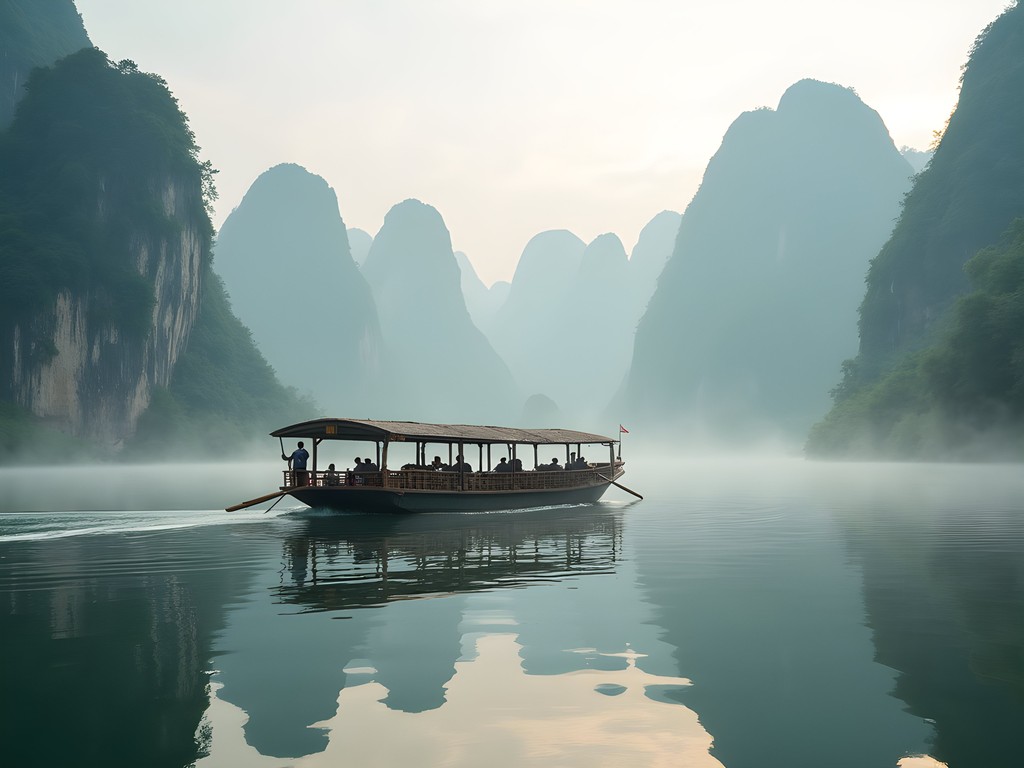
💡 Pro Tips
- Download transportation apps like DiDi and Baidu Maps before arriving in China
- Take screenshots of your destinations in Chinese characters to show drivers
- Consider buying a local SIM card at the Guilin airport for reliable maps and translation tools
Conquering Yangshuo by Two Wheels
Without question, renting a bicycle or e-bike offers the most rewarding way to explore Yangshuo and its surrounding villages. The flat valley floors contrasted with dramatic karst peaks create an almost surreal cycling landscape.
Standard bicycles cost ¥20-30 ($3-5 USD) per day from shops along West Street, while e-bikes (electric scooters) run ¥40-60 ($6-9 USD). My preference? Always the e-bike. The region's humid climate can make pedaling exhausting, and the extra range lets you reach distant attractions like the Yulong River and Moon Hill in a single day.
On my third visit, I discovered the joy of taking a waterproof daypack – absolutely essential during spring when afternoon showers can appear without warning. I've been caught in downpours while on my e-bike multiple times, and nothing ruins a day faster than soaked electronics and guidebooks.
Most rental shops will ask to hold your passport as collateral, but I've successfully negotiated using a cash deposit instead (¥500-1000). Always thoroughly check your bike/e-bike before accepting it, taking photos of any existing damage to avoid disputes upon return.
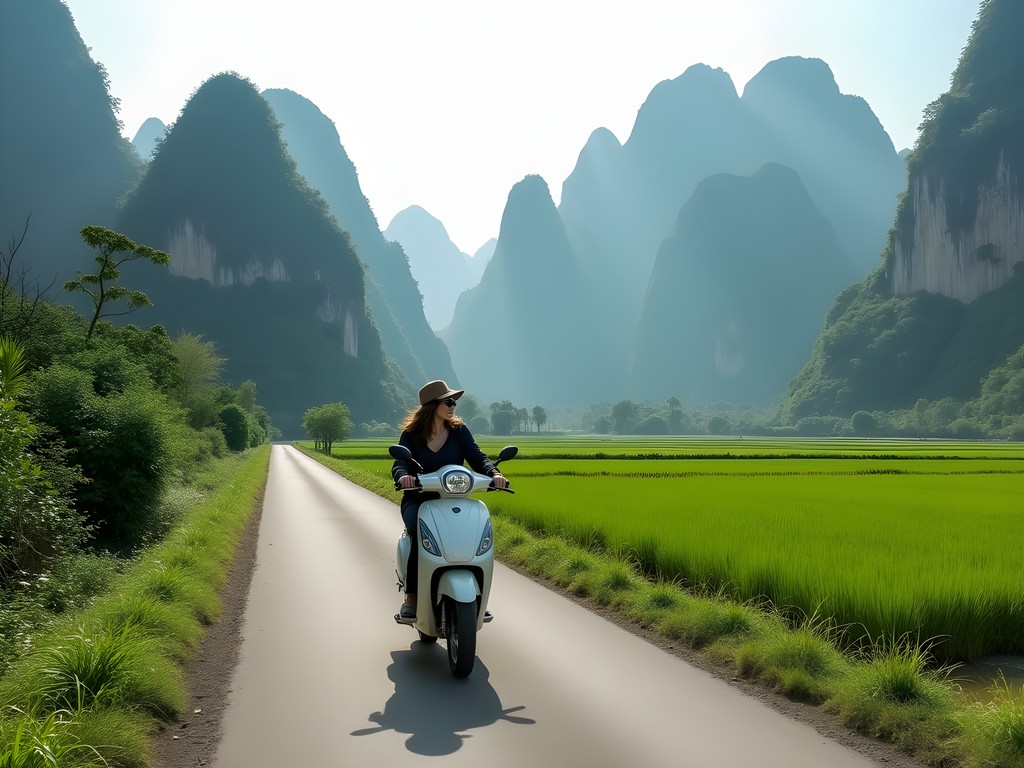
💡 Pro Tips
- Rent early in the morning to secure the best quality e-bikes
- Ask your accommodation to write down your destinations in Chinese characters
- Download offline maps as cell service can be spotty in the countryside
Navigating the Rivers: Bamboo Rafts & Water Taxis
The waterways around Yangshuo offer both practical transportation and unforgettable experiences. Bamboo rafts (though now made of PVC pipes for durability) remain the iconic way to travel sections of the Li and Yulong Rivers.
For the Yulong River, head to the Gongnong Bridge embarkation point where a 1.5-hour journey costs ¥240-300 ($35-45 USD) per raft (seats two people). This is one experience where bargaining is expected – I've typically negotiated 20-30% off the initial asking price, especially during shoulder season.
The shorter Li River sections near Xingping are more budget-friendly at ¥150-180 ($22-27 USD). For the best experience, arrive early (before 9am) or late afternoon (after 4pm) to avoid the tour group crowds and capture the magical light for photographs.
While exploring these waterways, I've found a dry bag to be absolutely indispensable. The bamboo rafts sit low in the water, and splashing is inevitable – I learned this lesson the expensive way on my first trip when my smartphone suffered water damage.
For those seeking adventure off the beaten path, ask local boatmen about water taxi services between villages. For around ¥100-150, you can arrange private transport to remote sections not accessible by road, creating a unique experience few tourists ever discover.
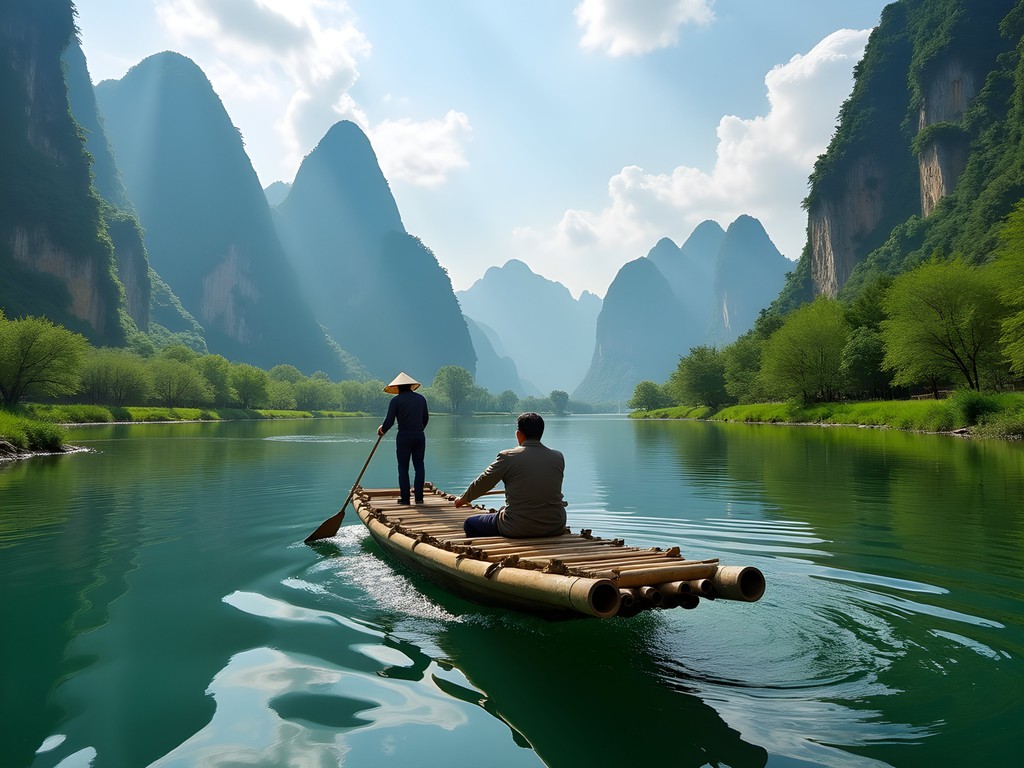
💡 Pro Tips
- Negotiate bamboo raft prices firmly but respectfully
- Bring small bills as operators rarely have change
- Wear water shoes or sandals as you may need to wade through shallow water to board
Public Transportation & Budget Options
For the budget-conscious traveler, Yangshuo's local buses offer exceptional value. The green minibuses connect Yangshuo with surrounding villages and attractions for just ¥2-8 ($0.30-1.20 USD) per trip. These buses depart from the main station near the West Street entrance, though schedules can be irregular.
Bus #1 runs to Gongnong Bridge and the Yulong River area, while Bus #2 heads toward Moon Hill and the Assembling Dragon Cave. I've found that having a phrase book is invaluable when using local transportation, as drivers and fellow passengers are often eager to help but speak limited English.
For groups of 3-4 travelers, shared taxis become cost-effective at ¥50-80 ($7-12 USD) for trips to nearby attractions like the Big Banyan Tree or Moon Hill. Always agree on the price before departing and confirm whether the driver will wait for your return.
During my solo trips, I've found that joining forces with other travelers from my hostel or guesthouse is the sweet spot for transportation value. By sharing a taxi for half-day excursions, I've managed to visit multiple sites while keeping costs comparable to public buses but with significantly more flexibility.

💡 Pro Tips
- Take a photo of your accommodation's business card to show drivers for your return journey
- For public buses, have your destination written in Chinese characters
- Learn the Mandarin phrases for 'how much' (duōshao qián) and 'too expensive' (tài guì le) for negotiating fares
Day Trips Beyond Yangshuo
Some of my most memorable experiences in the region have come from venturing beyond Yangshuo proper. The ancient town of Xingping (兴坪), about 25km away, offers a glimpse into rural Chinese life relatively untouched by tourism, plus the iconic view featured on the 20 Yuan note.
To reach Xingping, take the direct bus from Yangshuo's main station (¥10, 45 minutes) or negotiate a taxi for around ¥80-100. For the adventurous, cycling there makes for an unforgettable day trip, though I recommend an early start to avoid the midday heat.
The Longji Rice Terraces (Dragon's Backbone) present a striking contrast to Yangshuo's karst landscape. Located about 80km from Yangshuo, they're accessible via a combination of buses or a direct tour. While organized tours run ¥280-350 ($40-50 USD), the DIY approach costs roughly half but requires more planning and patience.
For these longer journeys, I always bring my collapsible water bottle. It saves space when empty and helps reduce plastic waste – a growing concern in China's scenic areas. I also pack a travel pillow for those bumpy bus rides on rural roads; it's made countless journeys more comfortable, especially when I've scored a window seat for those panoramic countryside views.
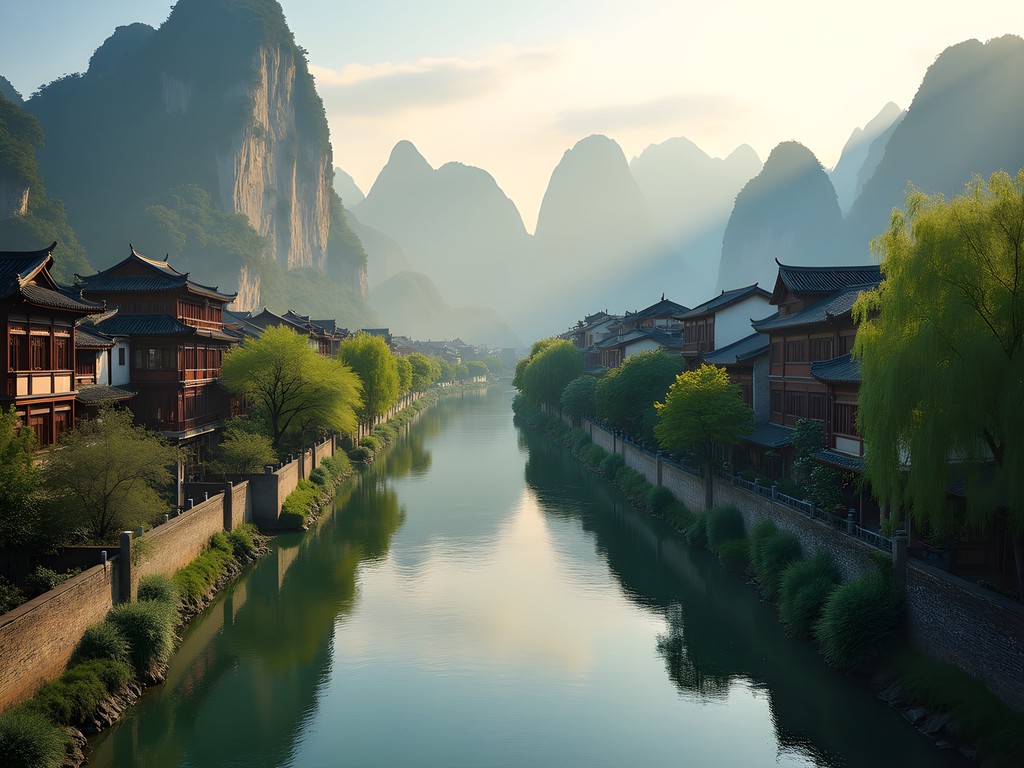
💡 Pro Tips
- For Longji Rice Terraces, consider staying overnight to experience sunset and sunrise views
- When visiting Xingping, climb Laozhai Hill for the best photography vantage point
- Always carry toilet paper and hand sanitizer when using rural bus stations
Final Thoughts
As my e-bike hummed quietly along a narrow path between vibrant green rice paddies, an elderly farmer looked up from his work, smiled broadly, and waved with genuine warmth. These spontaneous connections – impossible from the window of a tour bus – exemplify why thoughtful transportation choices transform good trips into unforgettable ones.
Navigating rural China independently might initially seem intimidating, but the rewards are immeasurable. From the freedom of exploring hidden valleys by e-bike to the gentle rhythm of bamboo rafts on the Yulong River, how you move through Yangshuo shapes your entire experience of this remarkable region.
Whether you're a seasoned solo traveler or making your first venture into Asia, Yangshuo offers transportation options for every comfort level and budget. Embrace the occasional misadventure, practice patience, and remember that sometimes getting slightly lost leads to the most authentic discoveries. The limestone karsts have stood for millennia – they invite you to slow down, choose the scenic route, and create your own path through this extraordinary landscape.
✨ Key Takeaways
- E-bikes offer the best balance of cost, flexibility and range for exploring Yangshuo
- Budget travelers should utilize local green minibuses for incredible value
- Spring offers ideal weather for outdoor exploration with fewer crowds than peak summer
- Learning basic Mandarin transportation phrases significantly enhances your experience
- Consider combining transportation methods for the most comprehensive experience
📋 Practical Information
Best Time to Visit
March to May (spring) and September to November (fall)
Budget Estimate
$30-50 USD per day including accommodation and transportation
Recommended Duration
5-7 days
Difficulty Level
Moderate

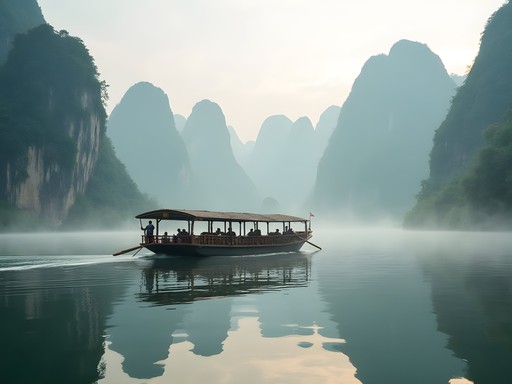
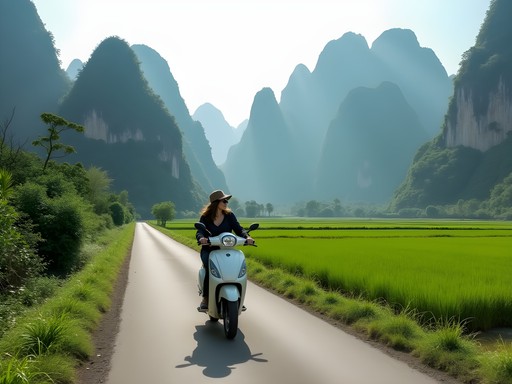
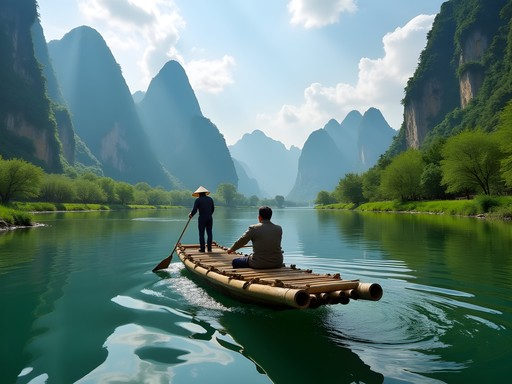

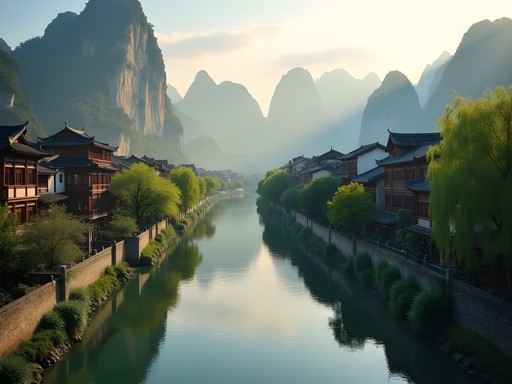










Comments
waveclimber
Those morning mist photos are INCREDIBLE! Heading there next spring and can't wait!
exploremate
Spring is supposed to be amazing there! I've heard the rice terraces are so green then.
waveclimber
That's what I'm hoping for! Planning to stay for a week - seems like plenty of transportation options to fill the time!
Taylor Moreau
Excellent guide, Jamie! I've been to Yangshuo several times for business retreats, and your transportation tips are spot on. One addition I might suggest is the private car option from Guilin Airport - costs about 300 RMB but saves considerable time and hassle, especially if arriving late. The countryside roads can be quite confusing after dark. Also worth noting that the bamboo raft prices are often negotiable, particularly in the off-season. I've found showing a bit of knowledge about local prices (and a few words of Mandarin) can reduce the 'foreigner price' significantly. The Yulong River rafts are more peaceful than the busy Li River section, for those seeking tranquility.
escapehero
Great guide! I'm planning a trip in October - is that a good time to visit? And how many days would you recommend staying in Yangshuo?
Taylor Moreau
October is actually one of the best times to visit Yangshuo - the weather is mild and it's past the summer rainy season. I'd recommend at least 3-4 days to properly explore the area. If you're interested in photography, the Li River at dawn is spectacular. I always carry my travel tripod for those misty morning shots of the karsts.
escapehero
Thanks for the info! Will definitely plan for at least 4 days then.
summergal7323
Those photos of the karsts are incredible! Can't wait to see them in person next month.
vacationclimber
Jamie's post is spot on about the bamboo rafts! We did the Yulong River route which was much quieter than the Li River section. Absolutely peaceful gliding between those karst mountains. Worth every yuan! Also, for anyone going during summer - start EARLY. We were on the water by 7am and had it almost to ourselves. By 10am it was getting crowded.
vacationlegend
Just got back from Yangshuo last month and this guide would have been SO helpful! We ended up renting e-bikes which was definitely the way to go - those karst mountains are no joke when you're pedaling a regular bike. The bamboo rafts were magical, especially in the early morning when there's mist on the water. One tip I'd add: download maps offline before you go because cell service gets spotty in the countryside. We got lost for 2 hours but honestly it led to some of our best memories - a local farmer invited us in for tea when we stopped to ask directions!
summergal7323
Did you feel safe on the e-bikes? I'm going solo next month and a bit nervous about the traffic.
vacationlegend
Totally safe! The countryside roads have almost no cars, just other bikes and the occasional scooter. Main roads in town are busier but still manageable. Just wear a helmet and you'll be fine!
Taylor Moreau
Excellent comprehensive guide, Jamie. Having visited Yangshuo annually for business over the past decade, I can attest to the accuracy of your transportation insights. One additional note for business travelers: the high-speed rail connection from Guilin to Yangshuo has dramatically improved over the years. For those with limited time, I recommend arranging a private transfer from Guilin airport directly to Yangshuo (approximately 300-350 RMB) - the time saved is well worth the expense when on a tight schedule. The contrast between the urban bustle of my meetings in Shanghai and the serene landscape of Yangshuo never fails to recalibrate my perspective.
roamexplorer
How's the public bus system for getting to the more remote villages? I'm on a tight budget and wondering if I can skip the e-bike rental.
moonlegend
The local buses are super cheap but they don't go everywhere. For the main spots like Moon Hill or Yangdi, they work great. But for the really remote villages, you might need to combine buses with some walking. I used my foldable daypack for day trips which was perfect when hopping between different transportation modes.
exploremate
Going to Yangshuo in November - is that a good time for the bamboo rafts? Worried it might be too cold or the water levels might be low.
Jamie Ferguson
November can actually be lovely! The crowds are thinner and while it's cooler, it's rarely too cold for rafting. Water levels are typically fine on the Yulong River, though the Li might be lower. Bring a light jacket and you'll be fine!
exploremate
Thanks so much! That's really helpful. Can't wait to experience those karst views from the water!
moonlegend
This guide is EXACTLY what I needed! Just got back from Yangshuo last month and wish I had this before going. The e-bike rental was definitely the highlight - we explored so many hidden villages and pathways that weren't in any guidebook. One tip I'd add: download maps offline before heading out into the countryside. Cell service gets spotty between those gorgeous karst mountains!
Taylor Moreau
Great point about downloading offline maps. Which route did you take with your e-bike? I found the Moon Hill area particularly stunning during my last visit.
moonlegend
We did Moon Hill too! But the absolute best was this tiny road that branches off near Yulong Bridge - took us through these incredible rice fields with barely any tourists. Just locals working and waving as we passed by. Pure magic!
Venture X
Premium card with 2X miles, $300 travel credit, Priority Pass